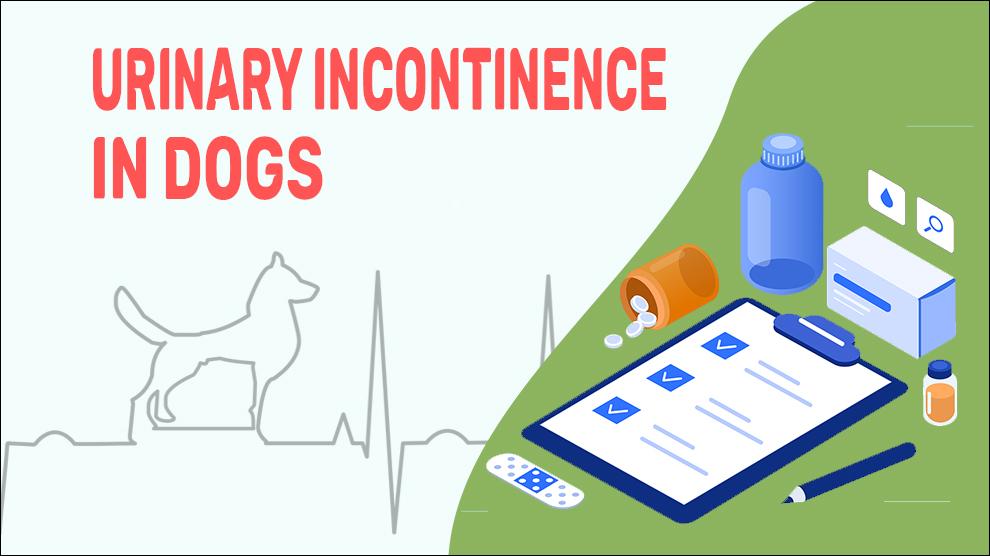What Is Urinary Incontinence In Dogs?
Urinary incontinence, or involuntary leakage of urine, is a fairly common problem in dogs caused by urethral sphincter incompetence. This condition is highly prevalent in older, spayed, large breed female dogs (10%–20%) but may be seen in male dogs and intact females too. So whenever a dog is said to be incontinent, it means that they are unable to control their bladder or involuntary loss of urine. Normal Incontinence in dogs occurs often in places where pets are resting (for example on their couch or bedding).
Urinary incontinence in young dogs may be owing to an anatomical defect in the transport of urine by the ureters from the kidneys to the bladder. Most commonly seen in female dogs, complications of ectopic ureters may be in conjunction with vulvar deformities. This rare type of incontinence can be stopped only by surgery. Trauma situations such as accidents causing a broken pelvis or being hit by a car could also lead to urinary incontinence.
Almost 20% of neutered female dogs suffer from urinary incontinence and it increases to 30% if the dog weighs > 20 kg. In most dogs, urinary incontinence occurs within 3 years of neutering, sometimes it may not be a matter of concern until later in life but at that time it can be complicated by diseases that increase urine production and water intake. The major reasons for urinary incontinence include urethral sphincter mechanism incompetence (USMI), over-active bladder (detrusor hyperreflexia), and ureteral ectopia.
The association of incontinence with hormone status has long been documented. Estrogen receptors are found in the urethral smooth, striated muscles, urethral mucosa, vasculature, vaginal walls, and supporting ligaments. In all of these areas, estrogen appears to have a trophic effect. Decreased estrogen levels are associated with decreased glandular secretions, urethral vascular atrophy, and loss of urethral muscle tone, affecting major components of the continence mechanism.
Symptoms Of Urinary Incontinence In Dogs
- Dribbling of urine when the dog is walking
- Pooling or spotting of urine underneath dog’s resting place
- Increasing wet spots on the bedding or floor
Treatment Options For Urinary Incontinence In Dogs
The treatment of urinary incontinence will vary depending on its underlying cause.
Ectopic Ureters: Surgical repositioning should be done to relocate the ureter to its normal position.
Bladder Stones: Surgical removal (cystotomy), Laser Lithotripsy, Non-surgical removal – Uro hydro propulsion (urocystoliths are removed using a special catheter with a saline solution flushing the stones through the bladder), and Dietary dissolution.
Diabetes: Oral medications, dog diabetes insulin, and syringes.
Cushing's Disease: Hormone replacement therapy. Mineralocorticoid replacement: desoxycorticosterone pivalate (DOCP-Novartis, Percorten-V) and fludrocortisone acetate (Bristol-Myers Squibb Company- Florinef).
Home Remedies For Urinary Incontinence In Dogs
- When the incontinence is sporadic or if the symptoms don’t bother the dogs so much or the dogs don't have any symptoms, you and your vet may simply continue to adopt the ‘wait and watch’ procedure.
- During their sleep most dogs tend to soil themselves, owners can provide the dogs a place for them to take rest that can be kept clean.
- Washable dog beds are available in the market and dog beds that are designed specifically for incontinent dogs are also available.
- Belly bands or doggy diapers can be used for dogs to prevent any leakage when they are active during the day.
How To Prevent Urinary Incontinence In Dogs?
- There is no real way to prevent urinary incontinence. Some of the breeds inherit the condition and others acquire it through other health issues.
- Consult with breeders/vets to find out if the breed has a history of incontinence.
- Spayed female dogs are more prone to incontinence.
Affected Dog Breeds Of Urinary Incontinence
German Shepherd, Rottweiler, English Springer Spaniel, Doberman Pinscher, Weimaraner, Old English Sheepdog, Dalmatian, Bearded Collie, Collie, Boxer, Middle Age Dogs, Senior Dogs
Causes And Prognosis For Urinary Incontinence In Dogs
1. Cause:
- Bladder Stones
- Canine Cognitive Disorder
- Ectopic Ureter
- Excessive Thirst
- Hormonal disorders
- Spinal Cord Disease
- Urinary Tract Infection
2. Mortality:
There is no documented mortality connected with incontinence. Older dogs are at greater risk of getting incapacitated than younger dogs.
4. Diagnosis:
- A complete blood count (CBC), chemistry profile
- Abdominal ultrasound
- X-ray
- Special radiographic dye studies
5. Prognosis:
Even after vigorous treatments, many dogs remain incontinent and may need specialized treatment so as to prevent unpleasant complications.
When To See A Vet For Urinary Incontinence In Dogs?
Contact your vet right away, if you notice:
- Dribbling of urine when the dog is walking
- Pooling or spotting of urine underneath dog’s resting place
- Increasing wet spots on the bedding or floor
Food Suggestions For Urinary Incontinence In Dogs
- High quality, carefully balanced palatable contents
- Moderate-protein -low-sodium diet, high-alkaline foods
- Root vegetables, Green Leafy Vegetables, Almonds,Avocado, Cucumber, Beets, Figs, and Apricots
- Herring, Sardines, Mackerel, Trout, Legumes (such as lentils, chickpeas, kidney beans)
- Plant-based protein sources – Chickpeas, Lentils, Nuts, Seeds, and potatoes
- Fresh fruit/ vegetables: Green beans, carrots, banana, apple, citrus fruits, watermelon, etc
Conclusion
Urinary incontinence in dogs is highly irritating for owners and they should consider the diagnosis with the proper clinical signs. As with any disease, the prognosis is dependent on the appropriate diagnosis, the extent of the disease, and the treatment chosen.

















